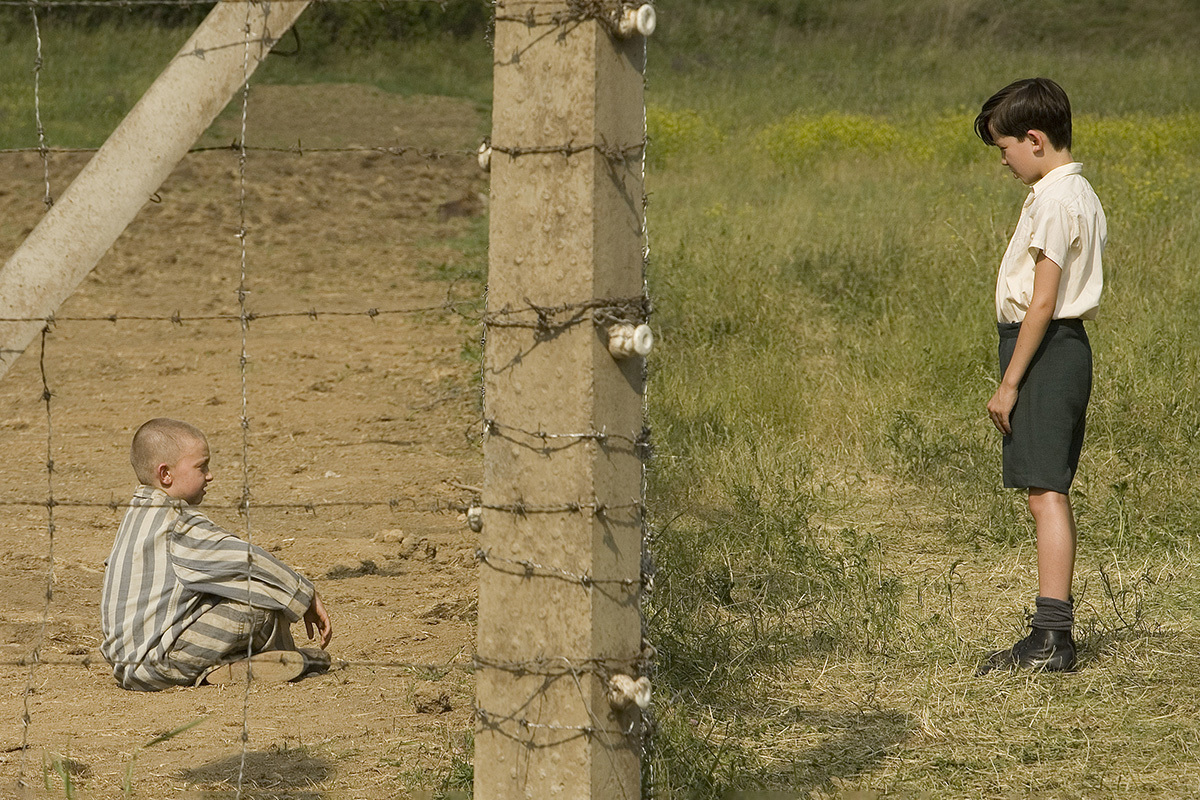Imagine a young boy, naive and full of youthful curiosity, stumbling upon a world shrouded in barbed wire and shrouded in a chilling silence. He sees children his own age, but separated by an abyss of incomprehensible cruelty. This is the heart of John Boyne’s poignant and powerful novel, “The Boy in the Striped Pajamas,” a tale that explores the complexities of childhood innocence, the insidious nature of prejudice, and the harrowing realities of war.

Image: librosalfabetizacion.blogspot.com
The story centers around Bruno, a nine-year-old boy whose world is abruptly upended when his family is forced to relocate to a remote outpost in Nazi Germany. As his father ascends the ranks of the Nazi regime, Bruno is oblivious to the darkness that permeates his new surroundings. What he encounters instead is a strange, fenced-off area teeming with people dressed in striped pajamas. It is in this haunting encounter that Bruno’s innocent curiosity collides with the chilling realities of the Holocaust.
Navigating Innocence and Ignorance
Through Bruno’s eyes, Boyne masterfully portrays the innocence of childhood, a state of mind both vulnerable and strikingly impervious to the horrors unfolding around him. Bruno’s naive questions and his seemingly harmless friendship with Shmuel, a boy on the other side of the fence, stand in stark contrast to the systemic brutality and dehumanization that define the concentration camp.
The novel poignantly reveals how even the most innocent hearts can be shaped by the prevailing influences around them. Bruno’s father, a high-ranking Nazi officer, unwittingly instills in his son a sense of superiority and prejudice, a stark reminder of how prejudice can be learned and internalized without conscious awareness. As Bruno’s interactions with the Jewish prisoners become more frequent, his innocence is gradually tested, leading to a profound sense of moral ambiguity that becomes a central theme.
The Power of Prejudice
At the core of the novel lies the exploration of prejudice, its insidious nature, and its devastating consequences. Bruno’s initial encounters with Shmuel are marked by a childlike wonder and curiosity, devoid of the malice that stains the actions of the adults around him. Yet, Bruno is also exposed to the pervasive antisemitic ideology that pervades his society. His simple questions about the “striped pajamas” and the “funny people” reveal how subtly prejudice is embedded in the fabric of his world.
The novel effectively highlights the power of influence, mirroring the way a child’s perception is shaped by societal norms and the words of adults. Bruno’s father, representing the embodiment of Nazi ideology, instills in him a sense of difference and fear. This underscores the potent influence of prejudice, even at its most subtle and insidious form.
The Horrors of War and the Inhumanity of Genocide
“The Boy in the Striped Pajamas” is not a story reserved for children; it is a stark and unflinching look at the horrors of war and the dehumanizing nature of genocide. While Bruno’s innocent perspective provides a unique lens through which to experience these horrors, the novel does not shy away from the reality of the Holocaust.
The concentration camp itself is portrayed not as a fictionalized, sanitized setting, but as a place of unspeakable cruelty and deprivation. The image of the striped pajamas, a symbol of forced labor and systematic dehumanization, becomes a potent visual that embodies the tragedy of the Holocaust.

Image: www.elmundo.es
The Power of Empathy and Understanding
Despite the weight of its themes, “The Boy in the Striped Pajamas” does not exclusively dwell on the darkness. There is a glimmer of hope in Bruno’s genuine connection with Shmuel, a connection that transcends the barriers erected by prejudice and war. Their shared humanity, their innocence in the face of an unforgiving world, creates a poignant reminder of the power of empathy and understanding.
The novel underscores that even in the face of unimaginable horror, humanity still exists. It emphasizes that empathy, kindness, and compassion can be found in the most unexpected places, even amidst the brutality of war. Bruno’s simple act of befriending Shmuel, a gesture of warmth and acceptance, serves as a powerful act of defiance against the backdrop of hate and intolerance.
The Impact and Legacy of “The Boy in the Striped Pajamas”
Since its publication in 2006, “The Boy in the Striped Pajamas” has garnered widespread acclaim and sparked meaningful conversations around the world. It has been translated into over 50 languages, adapted into a critically acclaimed film, and has been studied in schools and universities as a powerful tool for promoting historical understanding and fostering empathy.
The novel’s impact is undeniable. It offers a unique perspective on history, illuminating the human cost of war and prejudice. By presenting the Holocaust through the eyes of a child, Boyne has created a timeless story that speaks to readers of all ages, prompting them to confront uncomfortable realities, engage in critical reflection, and strive for a world free from the scourge of hate.
El Nino Con Pijama De Rayas
Conclusion
“The Boy in the Striped Pajamas” is a powerful and moving testament to the resilience of the human spirit amidst the darkness of war. Through the innocent eyes of Bruno, Boyne unveils the profound impact of prejudice, the inhumanity of genocide, and the enduring power of empathy and kindness. It is a story that challenges us to confront the horrors of history, honor the victims of injustice, and strive for a future where such atrocities are never repeated.






